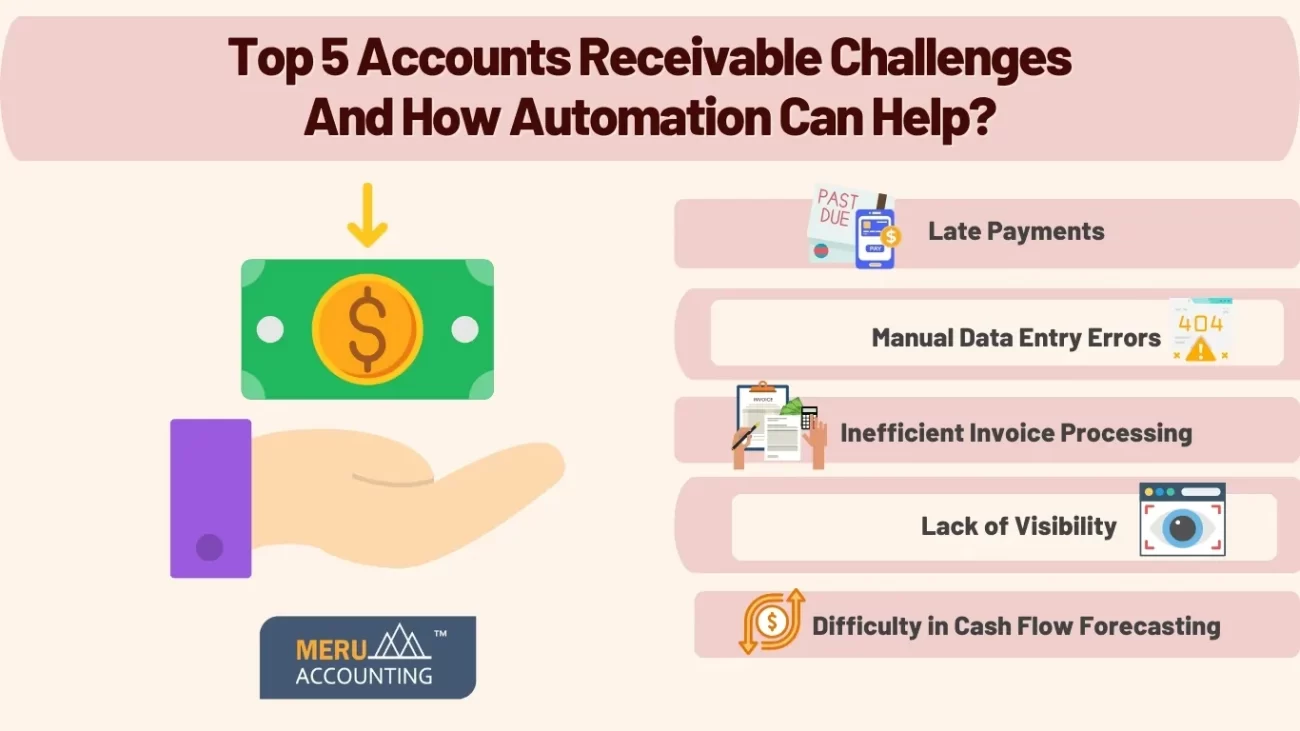
Accounts Receivable Challenges
Managing accounts receivable can be a complex task for businesses. However, with the right tools, such as automation, many challenges can be addressed efficiently. Using automation tools makes handling tasks like creating invoices, sending payment reminders, and reconciling accounts much easier for businesses. This not only reduces the chance of mistakes made by humans but also saves a lot of time. These automated systems can instantly show the current status of any outstanding payments, allowing businesses to make smart decisions quickly.
Late Payments:
Challenge: Late payments can disrupt cash flow and create financial strain for businesses.
Solution: Automation helps by sending timely payment reminders to customers, reducing the likelihood of overdue payments. Automated reminders ensure that customers are informed about their outstanding invoices, promoting prompt payments. This not only fosters a customer-centric approach but also provides valuable insights that can be utilized to further refine the accounts receivable process and strengthen customer relationships.
Manual Data Entry Errors:
Challenge: Manual data entry is prone to errors, leading to inaccuracies in the accounts receivable process.
Solution: Automation eliminates manual data entry by automatically capturing and inputting information from invoices. This reduces the chances of errors and ensures that the financial records are accurate, saving time and resources. Automation makes things simpler by checking information on invoices and comparing it with other financial records, like purchase orders and receipts. This helps make sure everything is correct and speeds up the process of putting everything in order.
If there are any mistakes or things that don’t match up, the automated system can catch them quickly, so they get fixed fast, preventing potential money problems. Besides making fewer mistakes and getting things right, the time saved from typing in data can be used for more important financial tasks, making the finance department work better. In short, using automation not only keeps financial records accurate but also makes managing money more straightforward and efficient.
Inefficient Invoice Processing:
Challenge: Traditional invoice processing can be time-consuming and prone to delays.
Solution: Automation streamlines the invoice processing workflow by automating tasks such as invoice creation, approval, and distribution. This speeds up the overall process, allowing businesses to receive payments faster and improve efficiency. Automation makes processing invoices faster and also makes the whole money cycle easier to understand. Automated systems can instantly tell everyone involved about the happenings of invoices – from creating them to getting them approved and sent out. This helps different parts of the business talk better to each other and makes it less likely that things will get stuck in the approval process.
Also, automation lets businesses create set rules and ways of doing things, making sure everything is consistent and follows the rules. By using automation, mistakes are less likely, and there’s a lower risk of missing important steps in getting approvals. So, in simple terms, automation not only makes getting paid quicker but also makes the whole money process clearer, more reliable, and less likely to have mistakes.
Lack of Visibility:
Challenge: Limited visibility into the accounts receivable process can lead to delays in identifying and resolving issues.
Solution: Furthermore, automation not only shows what’s happening with the money coming in but also helps businesses keep an eye on how things are going overall. With automated systems, companies can see right away if invoices are okay, keep an eye on how payments are going, and fix any problems fast. This makes it easier for businesses to take charge and handle their incoming money in a better way. Also, automation lets businesses set up rules and ways of doing things, ensuring that everything stays on track and is managed properly. By using automation, businesses can avoid mistakes and deal with any issues that come up quickly. In simple terms, automation not only helps companies get paid faster but also makes sure they have a good handle on their money situation.
Difficulty in Cash Flow Forecasting:
Challenge: Without accurate data and insights, forecasting cash flow becomes challenging.
Solution: Automation generates real-time reports and analytics, providing businesses with the necessary data for accurate cash flow forecasting. This enables better financial planning and decision-making, helping businesses stay on top of their cash flow management.
Conclusion
Using automation is a key way to solve common problems in Meru Accounting. It helps deal with issues like payments being late, mistakes made by people, not-so-effective work processes, difficulty in seeing everything clearly, and challenges in predicting how money will flow. Automation gives businesses the power to make their accounts receivable work better and improve their financial stability.


